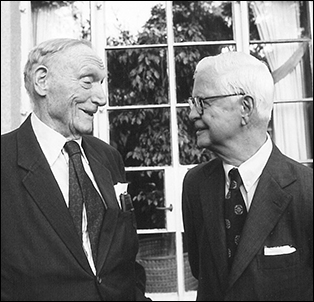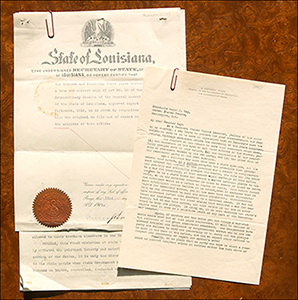Collections in the Classroom: LSU Librarians talk about teaching with archives
Class visits to Special Collections have skyrocketed over the past several years. In the fall and spring semesters of 2014-15, we reached 2,500 students, almost triple the number of the year before! On October 5, LSU librarians Tara Laver, Jennifer Mitchell, and Michael Taylor attended the Gulf South History and Humanities Conference in Natchez, Mississippi, where they shared some of the activities and assignments they have developed to make active learning with primary sources part of LSU students’ classroom experience.
 Tara Laver, Curator of Manuscripts, talked about how students have used antebellum plantation record books devised by Thomas Affleck. A former clerk and horticulturist who married into owning a plantation, Affleck was appalled when he discovered what he considered the haphazard bookkeeping methods used by fellow planters. In response, he created a standardized record book that was widely used throughout the South. A set kept on a Wilkinson County, Mississippi cotton plantation, now part of the papers of the Capell family in Special Collections, has formed the basis of a history graduate student research methodology assignment for the past nine years. The exercise gives students hands-on experience in the work of historians, including issues such as incomplete information, voices missing from the historical record, and deciphering handwritten documents.
Tara Laver, Curator of Manuscripts, talked about how students have used antebellum plantation record books devised by Thomas Affleck. A former clerk and horticulturist who married into owning a plantation, Affleck was appalled when he discovered what he considered the haphazard bookkeeping methods used by fellow planters. In response, he created a standardized record book that was widely used throughout the South. A set kept on a Wilkinson County, Mississippi cotton plantation, now part of the papers of the Capell family in Special Collections, has formed the basis of a history graduate student research methodology assignment for the past nine years. The exercise gives students hands-on experience in the work of historians, including issues such as incomplete information, voices missing from the historical record, and deciphering handwritten documents.
 "Papers and Prose: Touring LSU’s Literary History with Students," was the title of Jennifer Mitchell’s presentation. Created by LSU English professor Nolde Alexius, “Touring LSU: A Literary History” began as a way to get students out of the classroom and immersed in the university’s rich literary history. Special Collections has become a primary stop on the tour. Mitchell, Head of Manuscripts Processing, discussed her role working with Alexius. She also talked about how the tour has been tailored for visitors with different interests and learning objectives, from high school students to a local book club.
"Papers and Prose: Touring LSU’s Literary History with Students," was the title of Jennifer Mitchell’s presentation. Created by LSU English professor Nolde Alexius, “Touring LSU: A Literary History” began as a way to get students out of the classroom and immersed in the university’s rich literary history. Special Collections has become a primary stop on the tour. Mitchell, Head of Manuscripts Processing, discussed her role working with Alexius. She also talked about how the tour has been tailored for visitors with different interests and learning objectives, from high school students to a local book club.
 Finally, Michael Taylor, Curator of Books and History Librarian, presented on two class exercises that he developed to introduce undergraduates to historical research. Students rarely have trouble understanding the difference between primary and secondary sources, he pointed out; figuring out how to find and use such sources, however, is often an obstacle. One of the exercises Taylor discussed was on how to think creatively about locating primary sources, making the best use of what is at hand, and then integrating those sources into a research project. A second more advanced exercise, "Senator for a Day," draws from materials in the papers of Louisiana Senator Edward J. Gay related to the debate over the women’s suffrage amendment in 1918-19. It is designed to further introduce students to the challenges historians face, including how to see all sides of a story, craft a narrative, and appreciate history’s complexity.
Finally, Michael Taylor, Curator of Books and History Librarian, presented on two class exercises that he developed to introduce undergraduates to historical research. Students rarely have trouble understanding the difference between primary and secondary sources, he pointed out; figuring out how to find and use such sources, however, is often an obstacle. One of the exercises Taylor discussed was on how to think creatively about locating primary sources, making the best use of what is at hand, and then integrating those sources into a research project. A second more advanced exercise, "Senator for a Day," draws from materials in the papers of Louisiana Senator Edward J. Gay related to the debate over the women’s suffrage amendment in 1918-19. It is designed to further introduce students to the challenges historians face, including how to see all sides of a story, craft a narrative, and appreciate history’s complexity.
Special Collections plans to launch a revised "Teaching with Primary Sources" page on its website later this semester, with adaptable activities and assignments. In the meantime, feel free to contact the library about arranging class visits or developing course-based activities involving rare books and manuscripts. We are happy to help!
